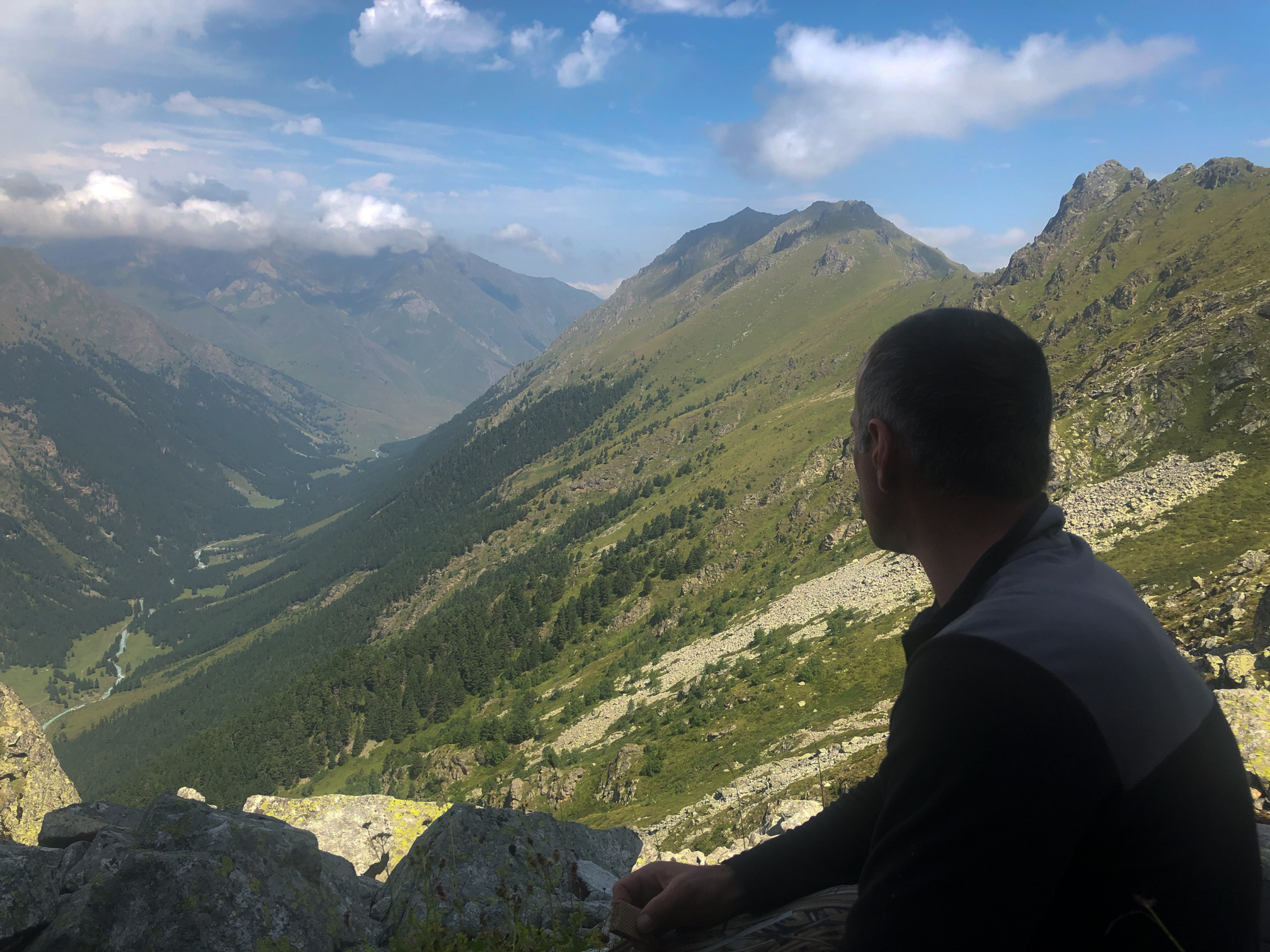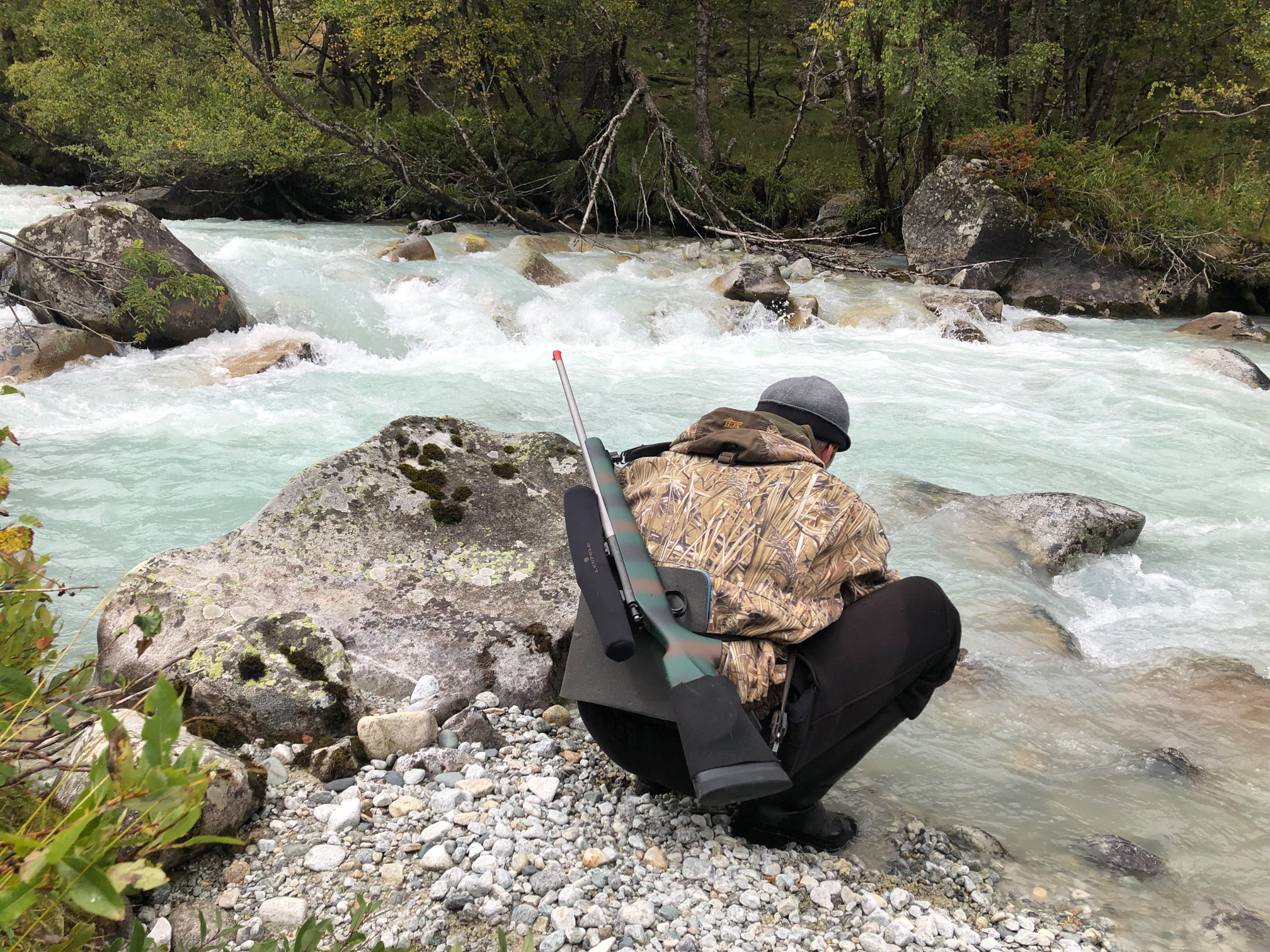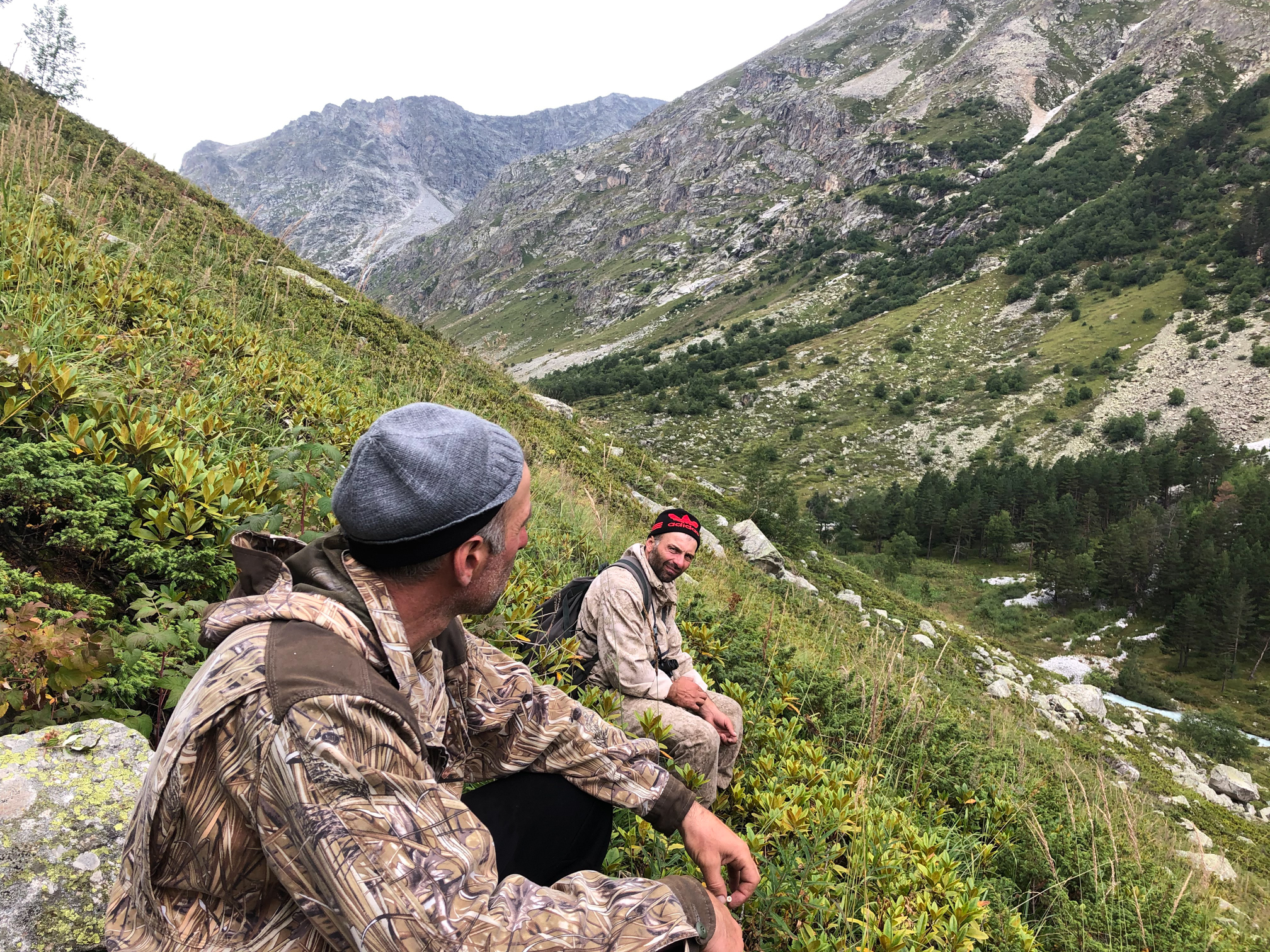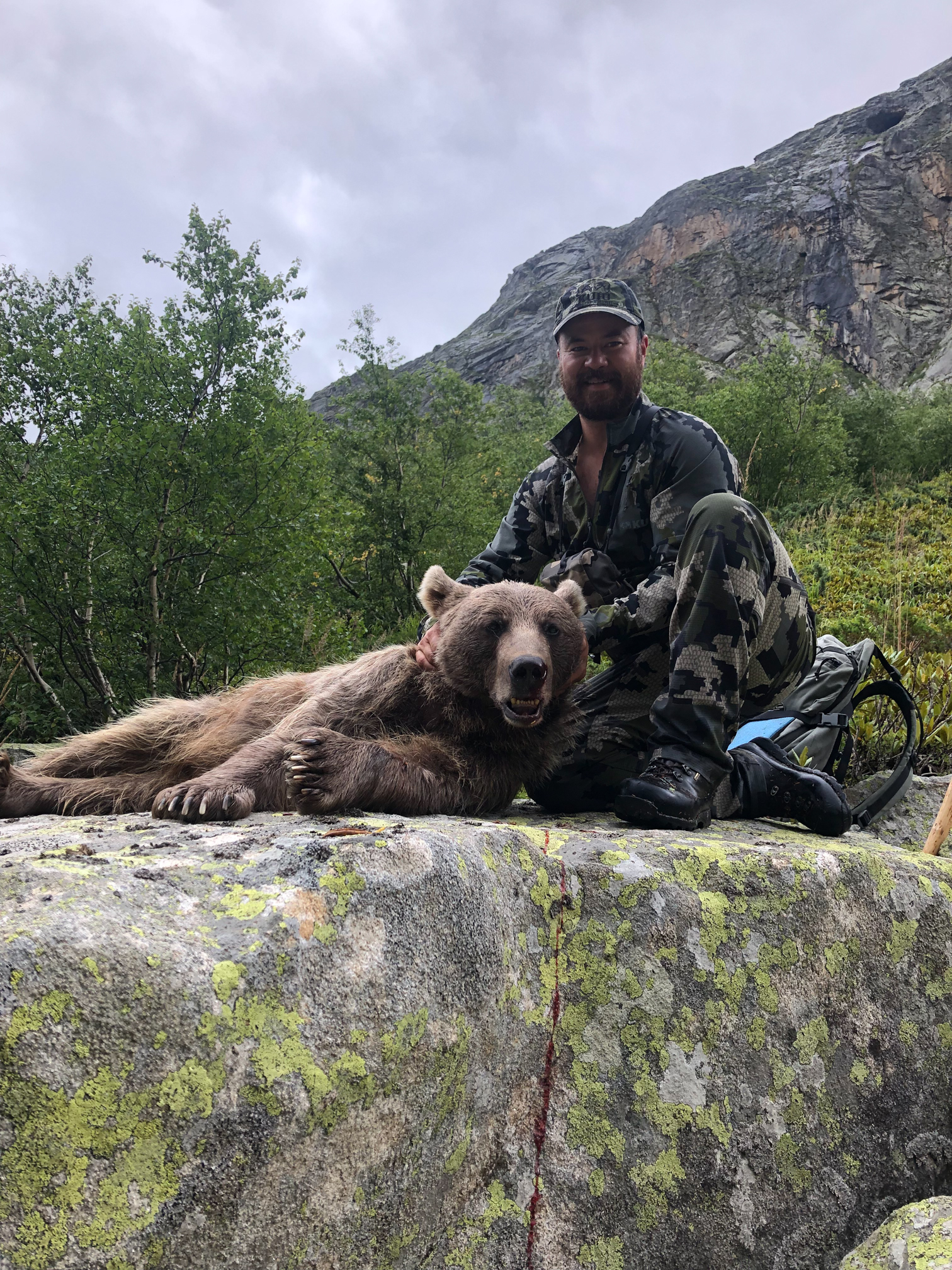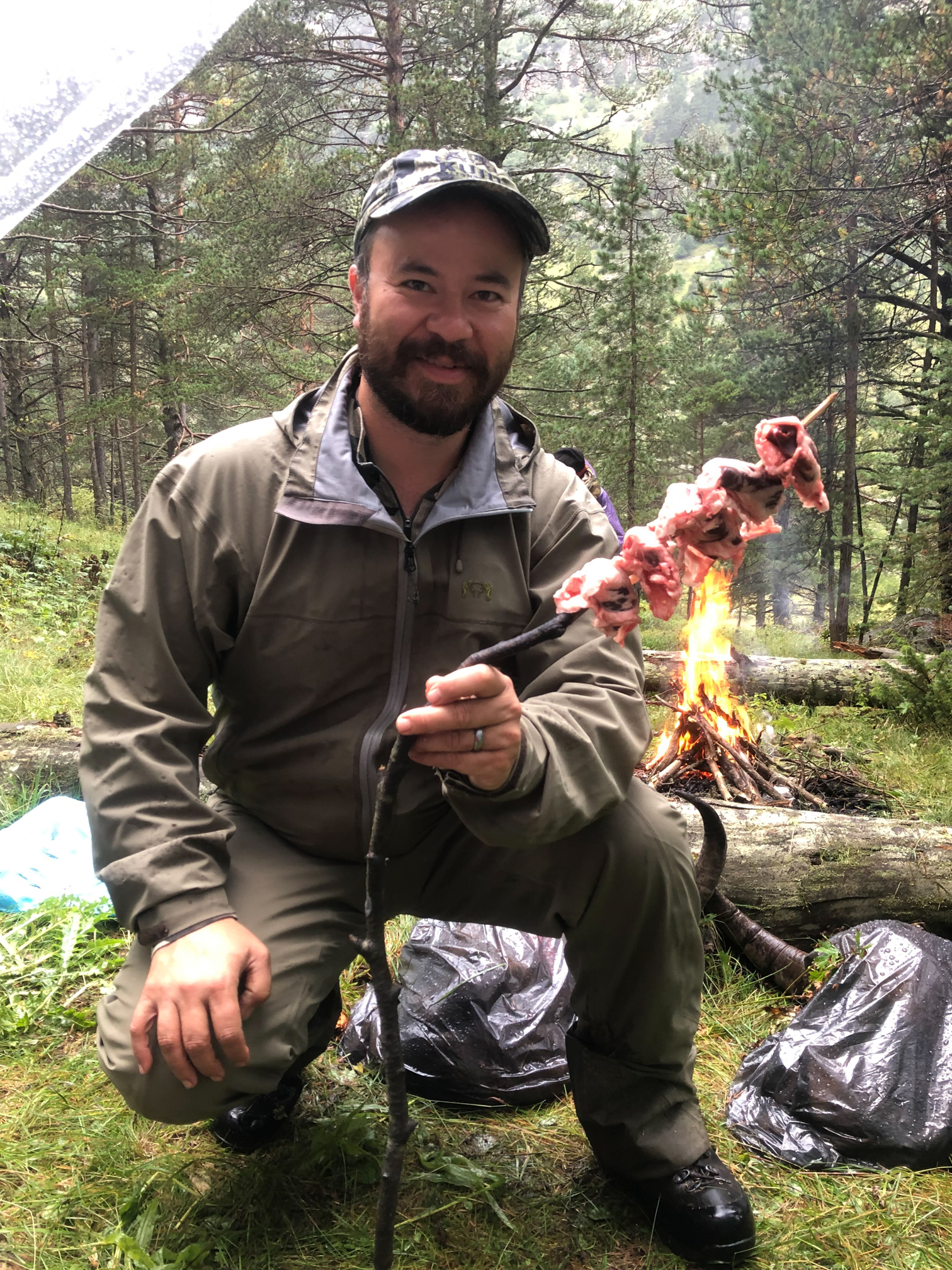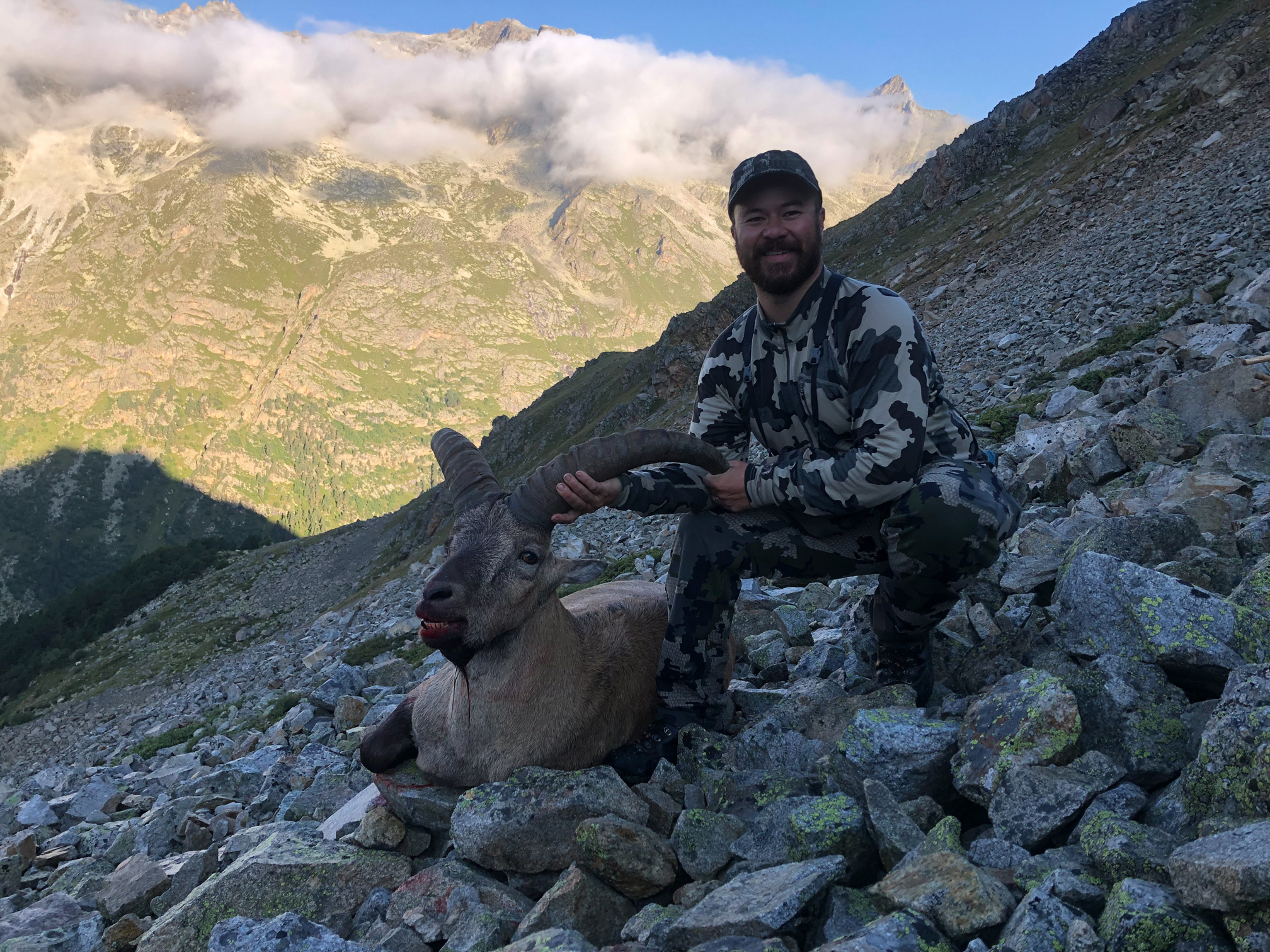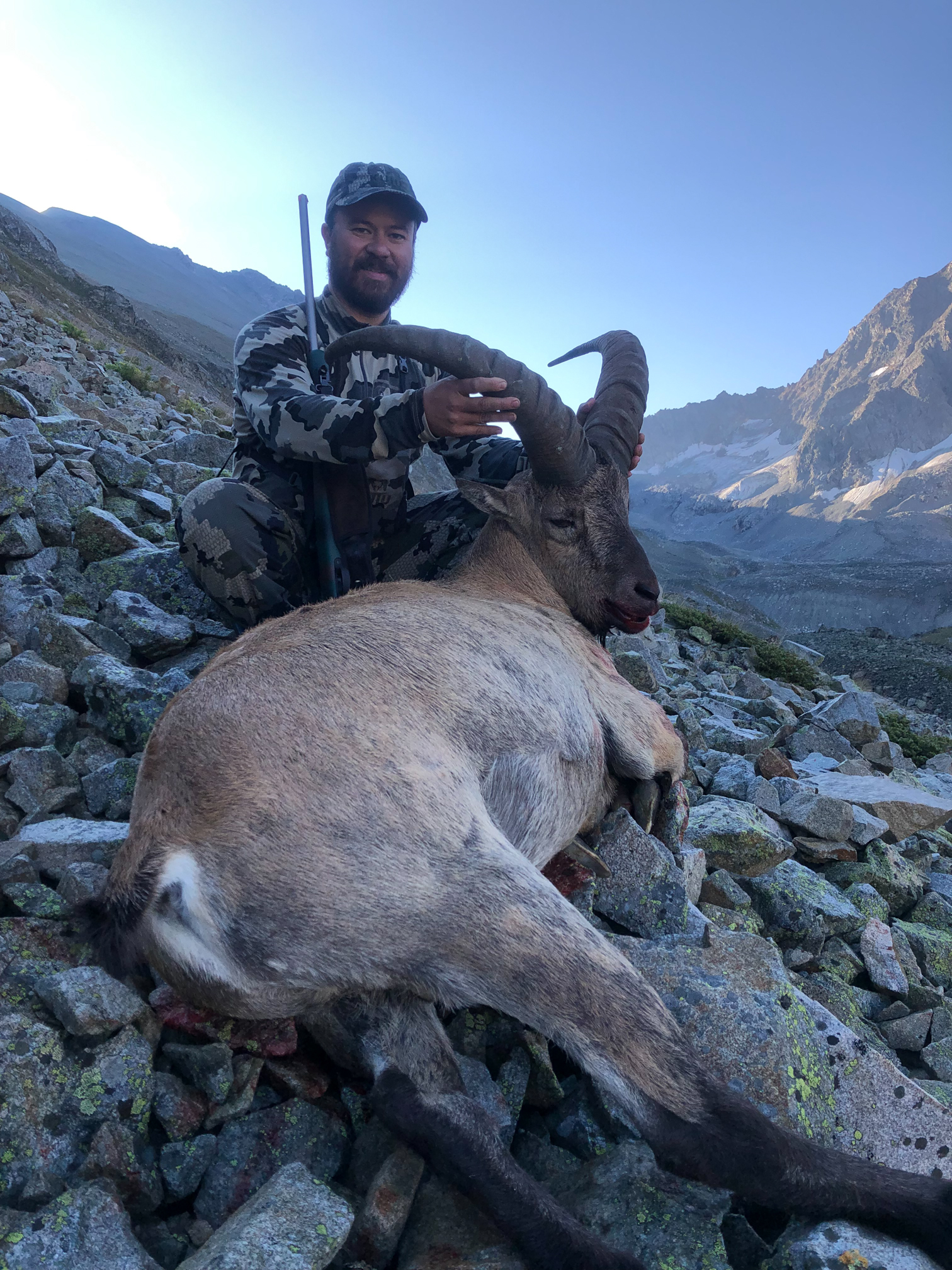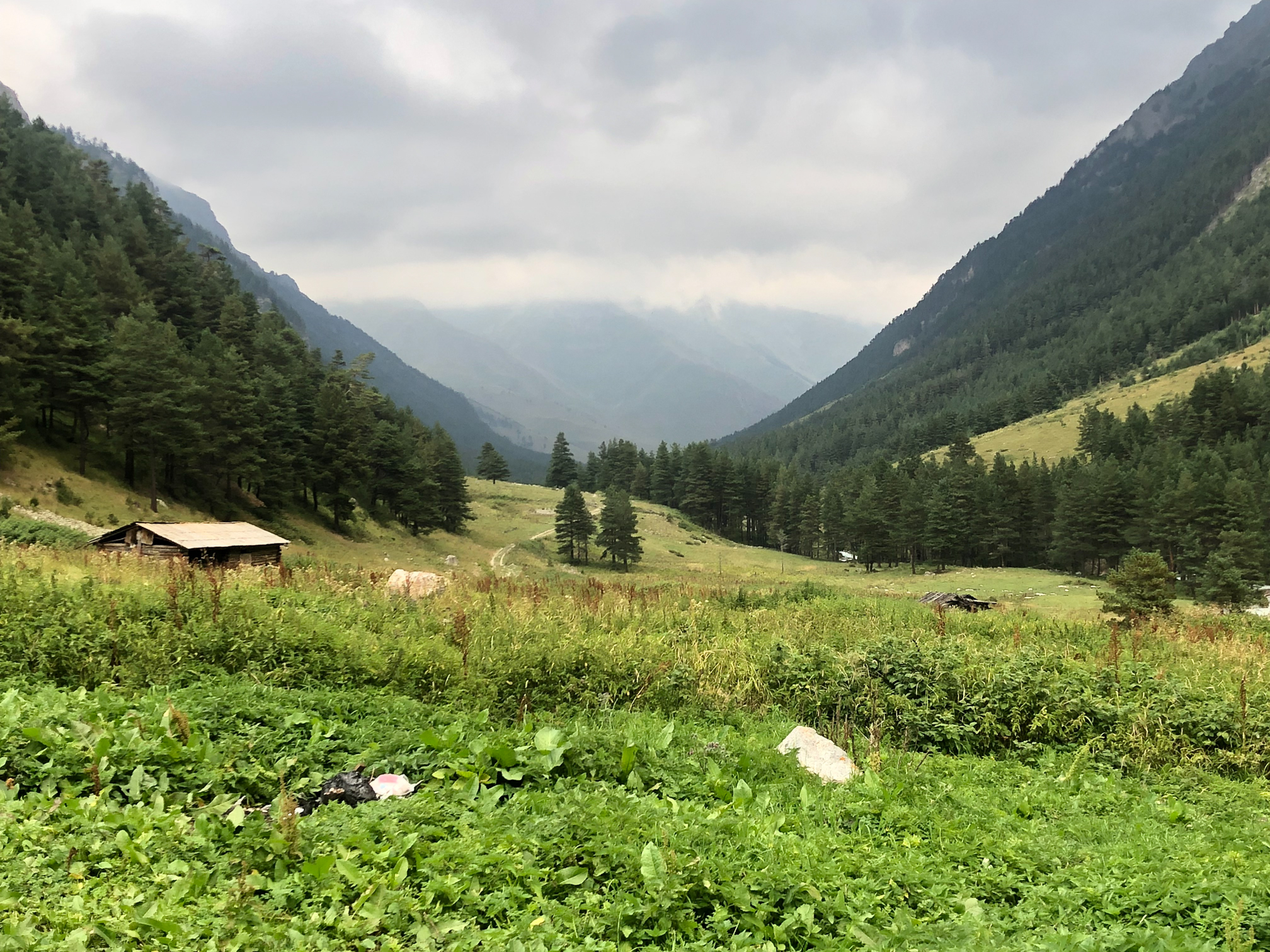The big tur rolled out from behind the rock, falling down the side of the mountain. A hundred feet below it hit the side and bounced. Gaining speed, it fell another two hundred feet and bounced. Then four hundred feet, another big bounce, then out of sight. A couple of seconds later I heard a loud thud. I looked over at my Russian guide, Kemal, and he was shaking his head. “No good,” he said. The 4,500-foot climb that morning had put me within 455 yards of an old, heavy-horned Mid-Caucasian Tur. This tough old animal had taken two direct hits through the chest and shoulder before going down. What Kemal knew and I didn’t, was that the tur’s final resting place was in a deep ravine accessible only with ropes, which we didn’t have.
Two years of planning had led me to a steep, boulder-strewn mountainside in the Caucasus Mountains of the southern Russian province of Karachay-Cherkessia. In 2017, I met Russian Professional Hunter Denis Cherentaev when he came to Minnesota for the local SCI show. Denis had just formed a partnership with my good friend Ted Shogren, who owns the booking agency The Sporting Trader, and wanted to promote his hunts.
Denis and I immediately hit it off. Denis started his professional hunting career in Kyrgyzstan, where he guided hunters for Marco Polo sheep and ibex for eight years. He then sold that business and started guiding hunters all over Russia, as well as to Africa and South America. Denis is very well spoken and the consummate professional. He’s a passionate bird hunter, and even traps muskrats in Moscow in his spare time!
By the time Denis left, we had planned for me to travel to Russia to hunt both Kuban and mid-Caucasian Tur the following year since I had already planned to hunt Dagestan Tur in Azerbaijan that year.
My trip to Azerbaijan in 2018 was a success. The outfitter, Kenan Sharifov, was excellent. We were supposed to do the hunt in early May, but due to regulatory changes, it was postponed to the first week in July. Azerbaijan in July is hot. Really hot. We had days where it was over 110 degrees. It took me five days to get my tur in the most unforgiving terrain I’ve ever seen. The Caucasus mountains were formed by the collision of the Eurasian and Arabian tectonic plates. The southern side of the Caucasus is formed by the uplift of the Eurasian plate. The slopes are the underside of the plate; extremely steep and in most places very unstable. That’s actually a bit of an understatement. The two drainages I ended up hunting were terrifying. I’ve hunted a lot of different mountains and never had any real fear. In my previous mountain hunts, there had been a time or two where a misstep would have lead to serious injury or death. On this hunt, that was about 50% of each day. It was mentally exhausting. On the second day of the hunt, we climbed all the way to the summit of the ridge through what looked like lunar terrain. The top of the mountain was the border between Azerbaijan and Russia. The difference between the two sides was shocking. Our side was vertical and grey; the Russian side was lush and green, with broad valleys.
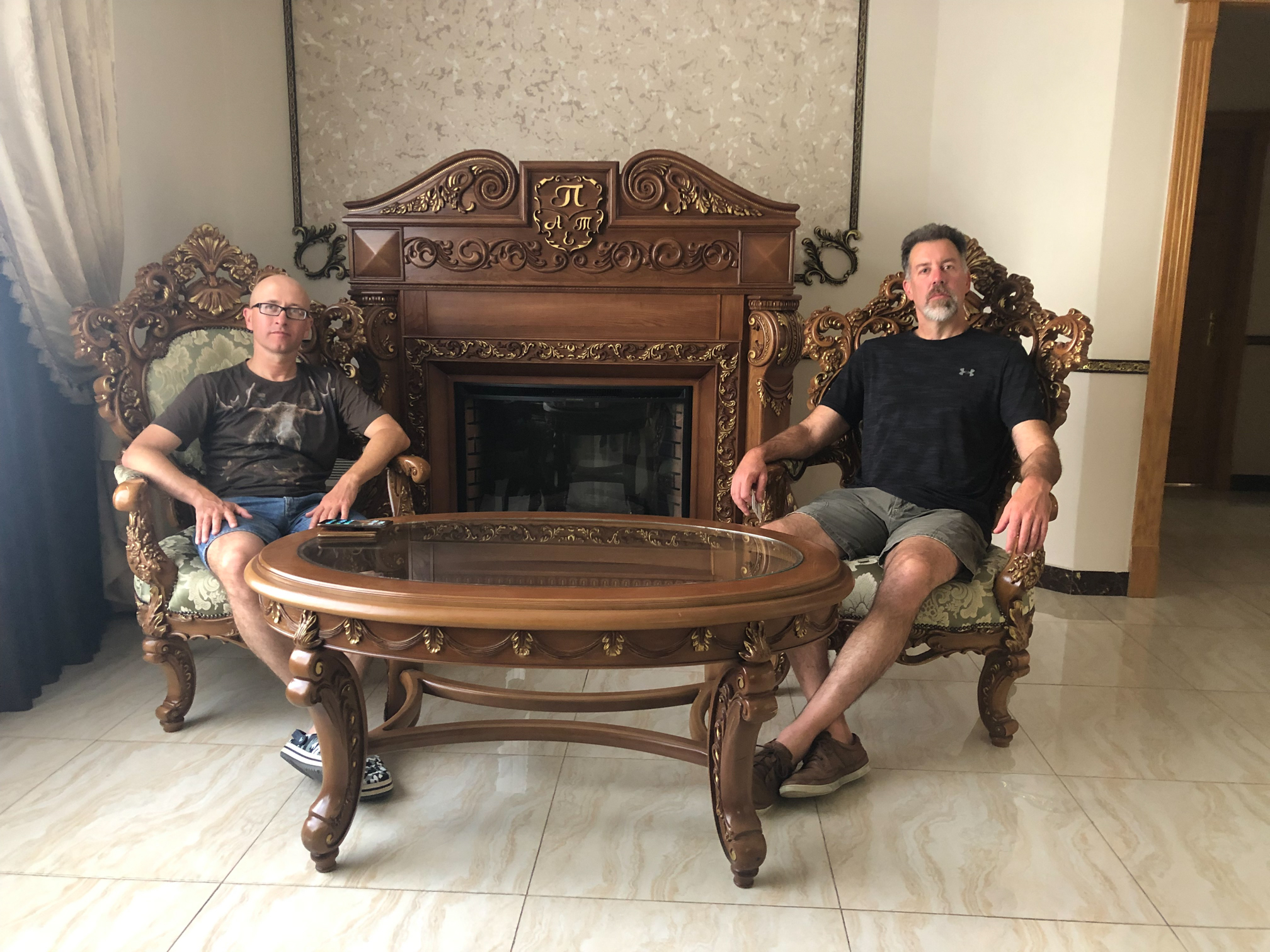
A tur hunt in Azerbaijan will test what you’re made of, and I believe every mountain hunter should do one in their lifetime. Having previously taken that test, I wasn’t necessarily sure I wanted to take it again in Russia. But time has a way of erasing your memories of “the suck,” so in August of 2019 I was off to Russia. My friend Jay McNaughton had purchased a hunt for Mid-Caucasian tur with Denis at our local FNAWS show. I convinced him to upgrade to include the Kuban and we decided to do the hunt together.
Between dealing with the regulations and paperwork on travelling with firearms in New York City, Aeroflot, and Russia, we’d spent hours shepherding our rifles along the way. Sadly, New York City was worse than Russia — On my flight home, US CBP held me up for two hours because a handgun with the same serial number as my rifle had been reported stolen some fifteen years prior. This aside, the flights there were uneventful and we spent the night in Moscow.
Moscow is a beautiful city. Truthfully, not at all what I was expecting. Modern, clean and with tons of green space, it’s worth spending a day or two on the front side of your trip to let your jet lag even out and give yourself some time in case your weapons or luggage don’t make it on your initial flight. From Moscow, we flew to Mineralnye Vody, then drove about five hours to the hunting area, where we met our local guides brothers Kemal and Naurus.
By the time we had dinner and organized our gear it was midnight. We needed to get up at 2AM to start, so sleep was going to be pretty scarce. I had no sooner closed my eyes when the alarm went off. After a quick breakfast, we piled into the Uaz and headed deeper into the mountains.

By 3 AM we were starting our climb up the lush, green mountains. While I couldn’t see it in the dark, a rushing glacial river ran through the center of a fertile valley grazed by cows and meat horses. The slopes were forested with pines and birch. The underbrush, which was a combination of rhododendron, wild raspberry, blueberry, and chokecherry was at times very thick, but we were able to use the bear trails in places so it wasn’t that bad. We arrived at the tree line just as it was beginning to get light.
Kemal and I immediately spotted tur as we started glassing. Or more accurately, Kemal spotted tur immediately and then pointed them out to me. Over the next couple of hours, we saw around thirty animals, all females with young. It was around 10 AM when Kemal spotted a male tur on the top of a ridge. We pulled out my spotting scope, and upon inspection, he said it was a small Kuban tur. In this area, you can find both the mid-Caucasian and Kuban, often in the same herds. We kept glassing that ridge, and then Kemal spotted another further up. “Big tur!” Kemal exclaimed. “Very big! Very, very big!” It took me a while to see what Kemal had seen, I was looking for a whole animal. After a minute or two I finally saw it – one very large tur horn sticking out from the side of a boulder. My first thought was that I hoped he had another one on the other side. “Sleeping,” Kemal said. “Hot.”
It was getting even hotter. The temperature was already in the 80’s, and with the oppressive humidity, it was a good time to lay in shade and sleep. It was probably a half an hour before he finally poked his head up above the rock. He definitely had both horns. Long and thick, the way they curled reminded me of a urial more than a tur. Bedded 1,100 yards from us, we would have to go a mile around a steep, boulder-strewn avalanche slide basin to get into position. By himself, Kemal likely could have been into position in twenty minutes. It took me about an hour and a half. As Kemal glassed for the tur, I got set up with my pack as a rest. I would be able to sprawl out on a big rock in a semi-prone position, though the steep upward angle was troubling. I figured that it was 50/50 that I’d scope myself when I pulled the trigger. I ranged the rock where we had seen the tur before starting our stalk — 455 yards, and my rangefinder said to hold for 360.
While we waited for him to stand, our position on the south face of the slope felt like an oven. The complete lack of any sort of wind was great from a shooting standpoint, but made for pretty miserable conditions. After half an hour, he stood up and I finally had a chance to see this magnificent old animal. I centred my crosshairs low on his shoulder and squeezed.
A split second later I was treated to the loud slap of a bullet hitting meat. When I came out of the recoil, he was just going down. “Kaput, good shot!” Kemal said slapping on the back. “Kaput.”
The tur had dropped behind the big rock where he had been sleeping. Watching through my binoculars, I was surprised to see him stand again, the blood on his shoulder plainly visible. “No shoot, Kaput,” said Kemal. I watched as he started slowly moving across the cliff face, one shoulder obviously broken. After another thirty seconds or so had passed, I looked at Kemal and asked, “Shoot?” He gave me a very emphatic no, saying once again the tur would soon be “Kaput.”
Sometimes, you need to use your own judgment on things. I’ve always felt that if the animal is on its feet, you keep shooting. Disregarding Kemal’s instructions, I centred the crosshairs on his shoulder and squeezed off another shot. I heard another loud slap when the bullet hit and saw the tur on the ground, struggling to rise. I cycled another round. “NO SHOOT! KAPUT!” Kemal said, this time more emphatically. I watched through the scope as the tur rose again, two streams of blood now running down his shoulder. Amazingly, he took off, one leg pinwheeling as he went uphill towards the top of the ridge. I’ve always thought that animals go downhill when fatally hit. Even with one shoulder obviously shattered, this guy was trying to go over the top of the mountain. I watch him go about fifty yards before he stopped. I squeezed off the last shot and he took off again. As I reached into my pocket looking for another shell, I looked at Kemal, who was now shaking his head. I chambered a round, and found him in the scope, just as he went into a small cut that blocked my view. “Kaput,” I heard again. This time it was true. A few seconds later I watched the tur tumble out of the cut. He bounced down the side of the mountain, going out of sight. This was followed by a loud thud as he hit the bottom.
What I didn’t realize is that there had been a very specific reason that Kemal didn’t want me to keep shooting the tur. He wanted it to lay down and bleed out. If I had held my fire and the tur had died where I had initially shot it, we could have retrieved it right then. My shooting had pushed the tur towards an area that is cliffed out, and that was where his carcass was now laying. To get to him, we’d need ropes, which we didn’t have. Unfortunately, given the heat and the 1,400-foot fall that it took after the shot, the meat and cape would be a total loss by the time we would be able to retrieve the animal. I was torn over the loss, but the mountains can be unforgiving at times.
My plan for the following day was to sleep in, and then have a leisurely day glassing the slopes for the smallest of the brown bear species, a Caucasian/Syrian Brown Bear. We had covered about 9,000 feet up and down the mountain, and I was sore really short on sleep. When we got back to our little cabin that night, Denis and the guides decided on a change of plan. From where we were camped to where we had hunted the first day was over an hour drive on rough roads. There was a much smaller shepherd’s cabin in that location. We were told to pack just what we’d need for a spike camp for a day.
My clothing for the trip was pretty simple. Kuiu Tiburon pants and shirt (the best hot weather clothing I’ve ever found), First Lite Aerowool boxers, Darn Tough boot socks with Injini liners, Kennetrek Mountain Extreme and a big floppy hat. I threw in my rain gear, a couple of extra pairs of socks, a light puffy, my Sitka Mountain Jacket and a handful of Pro Bar’s, Gels, and some BCA’s and my sleeping bag and pad. At 2 AM, the alarm went off and we piled into the truck and headed back to the hunting area. So much for getting caught up on sleep!
When we got there, they handed me a walking stick and we started up the side of the mountain. Even though it was cool in the pre-dawn darkness, the humidity was near 100%. Within two hundred yards I was once again soaking wet. We climbed to a basin stopped at the edge of it just as the sun was coming up. While there are more wild berries in the Caucasus than any other place I’ve ever seen, they wanted to be in this spot at dawn because it was a good place for bears. Kemal spotted one, but it moved into the brush and we never saw it again.
Jay, Denis and Naurus then started up to the top of the mountain. While we’d been looking for a bear, we’d seen 20-30 female tur cross over to the other side of the ridge. So while they hoofed it up another 3,000 feet, Kemal and I settled into a nice sunny spot and continued to glass for bears. No more bears came out, so we hiked back down to the shepherds cabin on the river and had some lunch. We spent the rest of the day glassing the slopes for tur and bear, but didn’t see anything besides females and a couple of very young male tur.
Jay and the guys got back to camp at dusk. They had put in another big day. They had found a group of male tur, but no shooters. After a supper of noodles with a little tinned meat, they came up with a new plan. There was a spot about six miles upstream where there was a natural salt lick that the animals like to hit in the mornings. We would get up at 2AM and hike up to that spot with our gear. If Jay didn’t have success, we’d set up camp there and continue to hunt further up the valley.
So with a grand total of about six hours of sleep over the course of two nights, we took off on a trail that paralleled the rushing glacial river. We stopped right as the first rays of dawn were visible in the eastern sky. Because the temperature was below the dew point, I, of course, was soaking wet. But even in the cool, humid air, I was pretty much completely dry within 15-20 minutes.
As it got light out, Kemal took Jay further up the valley to start glassing. Denis, Naurus and I found where a big pine had fallen across the river and crossed to the other side. This was a bit unnerving, trying to maneuver through the branches with a pack on. Falling in, while it may not have been fatal, would have been really unpleasant. We made it across and about a hundred yards into the trees, found a beautiful, flat clearing which was an absolutely perfect campsite.
We settled in, using the trees for cover and started glassing the tops of the ridges. We saw lots of females, but no males. Around 10:00 Kemal and Jay returned. They hadn’t seen anything at the lick.
I consider myself to have above average bush skills, but compared to Naurus and Kemal I would give myself a one on a scale of one to ten. Using just a Swiss Army knife, they constructed our entire camp using a very long, thin piece of clear plastic and some twine. The shelter they built covered all five of us and our gear. We had three big storms while we were there and all of us stayed dry and comfortable. Each stake and pole was perfectly trimmed and sharpened. Their knots were perfect; everything was square and tight. Our camp looked like it came straight out of the Boy Scout Field Guide.
With camp built, Jay, Denis, and Kemal decided to hunt up the ridge behind our camp. Naurus and I would cross the river and hunt upstream, looking for a bear for me or a tur for Jay. The day was pretty uneventful with the exception of the storm the rolled through mid-day. For a good hour we hunkered down under a spruce tree as the lightning flashed, the thunder boomed, and the hail pounded down. I hoped that Jay and the guys were able to get down to the tree line and not stuck in the alpine when the storm hit.
About an hour before sunset, Naurus and I were glassing the mountains behind our camp. At the very top was a large cave. Suddenly, just like something you’d see in a painting, a bear walked out of the cave. From where we were, it was a little over a thousand yards. But there was an uncrossable glacial river between the bear and us. With not a lot light left, we had no way to get there in time, so unless he decided to come all the way down the mountain, we’d have to be content with just watching him. The bear didn’t come down the mountain and actually headed to the east towards where the other guys were hunting.
Just as the bear went out of sight we heard a shot. About twenty seconds later, we heard another shot. That’s never a good sign. We decided to head back to camp and wait for them to get back.
It was probably 10:00 when they came slogging back to camp, very heavily loaded in another huge rainstorm. They had found a group of tur that had two big males, one mid-Caucasian and one Kuban. In this area, you can find both species. After Jay shot the first one, he had to do a hundred-yard dash straight up the side of the ridge to get into position to get a shot at the second one. In less than a minute, he had two eleven-year-old tur on the ground. I was very happy for Jay, but even happier for myself when Denis handed me a liver and the caul fat from one of the animals. Despite the pouring rain, we managed to get the fire roaring again and we spent the next hour and a half roasting chunks of tur liver wrapped in caul fat over the fire. Tur liver is exceptionally mild, even coming out of an eleven-year-old animal. The actual meat is better than anything I’ve had in North America or Africa. After not having had any real amount of protein for three days, the nutrient-rich liver was just what our bodies needed to replenish.
We actually slept in until sunrise the next morning. Since we were on day three of our one-day spike camp, I assumed that we’d be packing up and heading to another hunting area that only had Kuban tur, where I’d finish my hunt. After a big breakfast of fire-roasted, caul fat-wrapped tur liver and tea, I was surprised when they told me that we’d keep hunting in this area. Kemal had been the head game biologist in this area for many years before becoming a hunting guide and knows these mountains and the animals that live there like the back of his hand. He felt that they could find me a good Kuban tur in this area and save me the hassle of moving to a new camp. Our plan was to go another five or six miles upstream, to where the valley itself is above the tree line.
We were straight across from the cave where we’d seen the bear the night before when Naurus suddenly dropped down and hissed, “Bear!” Looking across the river, I could see a bear standing on a big flat rock, eating berries. “Too far,” I said as I looked at him through my binos. I’m used to seeing Rocky Mountain and Alaskan grizzlies. To me, it looked like it was well over 400 yards away. “No, no, no,” was the reply and they encouraged me to pull out my rangefinder. I was shocked to see that it was only a bit over 200 yards.
I was shooting my New Ultra Light Arms .270 Weatherby, loaded with 150 grain Berger VLD’s. This same load had crushed the tur I shot in Azerbaijan the previous year, but had failed to anchor my tur just a couple of days before. I hoped it was enough bullet for a brown bear.
The wind was good and the bear had no idea we were there and wasn’t going anywhere, so I took the opportunity to just watch him. Bears have always fascinated me and I hunt them whenever I get the chance. After watching him scarf down raspberries and blueberries for a few minutes, I centred the crosshairs on his shoulder and squeezed.
He vanished.
While I don’t speak Russian, I’m pretty sure that the excited banter between Naurus and Kemal roughly translated to, “Where the fuck did he go?” We glassed for another fifteen to twenty minutes, but didn’t see anything. I was hoping to hear a death moan, but the river was roaring. I felt like my shot was good, but now I was starting to have second thoughts. Kemal and Naurus reassured me that he was, “Kaput.”
So for the second time in half an hour, I had to cross the slippery pine tree back across the river. While it had looked like easy country where I shot the bear, looks are often deceiving. The carpet of berries and rhododendron was waist high and concealed lots of big holes and loose rocks. When we finally got to the big rock where my bear had been, we found him dead directly behind it. The bullet had blown through both shoulders, with a big piece of the jacket coming to rest just under the hide on the off-side. I think bullet went through the first shoulder and then detonated inside his chest cavity, killing him like a lightning strike.
I was shocked by the size of the bear. I would estimate his weight at about 250 pounds. Basically, the size of a good “eater” black bear in my home state of Minnesota. Kemal said that he was probably four or five years old. Not a huge old boar, but an average bear for the area. Both Kemal and Naurus were very happy that I shot him, as they lose a lot of calves and foals to these bears in the spring.
We brought the hide back to camp, both of them absolutely refused to take any of the meat for fear of trichinosis. We spread the hide out, then re-crossed the river and continued with our plan to hunt further upstream.
We slowly worked our way up the river, glassing everything we could. Aside from just a couple of females, nothing was moving. By mid-afternoon, we had left any big trees far behind and could now see the big glaciers that fed the river. Of course, it had to start storming. First, the fog rolled in making it impossible to glass, then big, black storm clouds filled the skies. We tried to tuck ourselves into some brush, but it didn’t give us much cover. The rain poured down and the wind off the glaciers was freezing. We could do nothing except sit there, cold and miserable, for a couple of hours before the rain started letting up. With everything still fogged in, we decided to call it a day.
We were about halfway back to camp when the fog started breaking up, so we slowed down and started glassing. The storm had changed everything. There were tur everywhere on the tops of the ridges. As Kemal and I glassed one set of hills, Naurus headed closer towards camp to glass that area. While Kemal and I didn’t see any shooters, it was very heartening to see at least a dozen males in different groups. We met up with Naurus in the same spot where I’d shot the bear. He said that a huge Kuban tur had crossed the top of the ridge, headed to the high basin where Jay had shot his two the day before.
The next day started at 3 AM. Being that it was day four of our one-day spike camp experience, we needed to get this done. Aside from some cookies and tea, were pretty much out of anything to eat except tur. Because we were doing multiple stream crossings every day, as well as constantly climbing through we brush, my boots never had a chance to dry completely and were starting to leak. My socks had long since lost their cushion and the anti-microbial treatment on my clothing was completely overwhelmed. In a nutshell, it was do or die time. Regardless of whether or not I was successful, we’d be pulling out that day.
The climb was tough, but not anywhere near what we did the first day. We were camped at a lot higher elevation, so the tree line was a lot closer. But bushwhacking through rhododendron in the dark is really unpleasant. It’s not devil’s club, but it sucks.
We got to the bottom of the basin at first light. Kemal and Naurus started glassing the east-facing slopes where Naurus had seen the big tur heading the previous evening. On this trip, I had yet to spot a single living creature before the guides. Nevertheless, I decided to start glassing the west-facing slopes while they found the tur. I actually thought I might get to see a bear, as that was where the guts from Jay’s tur were.
Almost immediately, I spotted a male tur. I tapped Kemal on the shoulder and said, “male tur,” pointing up the slope. Sure enough, I had found the big tur. And I actually spotted it before them!
Naurus was going to stay in place to watch the tur, while Kemal and I climbed up another 500 feet up to the very edge of the trees. It was actually a lot further than it looked. When we finally got there, Kemal told me to get set up to shoot while he located the tur.
There was a big rock that I could use for a rest, but I’d be shooting from a standing position. Not ideal, but it would work. There were now four males out in the scree in front of us. Kemal indicated that I should shoot the second one from the bottom. I ranged him at 400 yards and got behind my rifle.
Remember earlier when I said that I couldn’t wear my glasses, but that it wasn’t a problem for most of the trip? Well, the problem happened here. The sun was still behind the ridge, so the grey tur blended in really well with the grey rocks. I picked out an easy to distinguish rock and got behind my rifle. I couldn’t see him. Setting my rifle down, I looked through my binoculars. There they were, slowly feeding away from us. Focusing on that spot, I got behind my rifle again. No tur.
If you’ve ever had this happen, the panic is almost indescribable. After days of hard climbs and hours spent behind glass, to finally get into position and then not be able to see the animal is maddening. Wide-eyed, Kemal gave me his best, “What the fuck are you doing? Just shoot the damn thing!” look. I went back and forth several more times. Utterly confused, I was about ready to scream. With everything up close blurry, I hadn’t even looked at the scope. Then I remembered that I had turned it all the way down when we followed up on the bear. Giving it a good twist up in magnification, I got behind it and voilà!
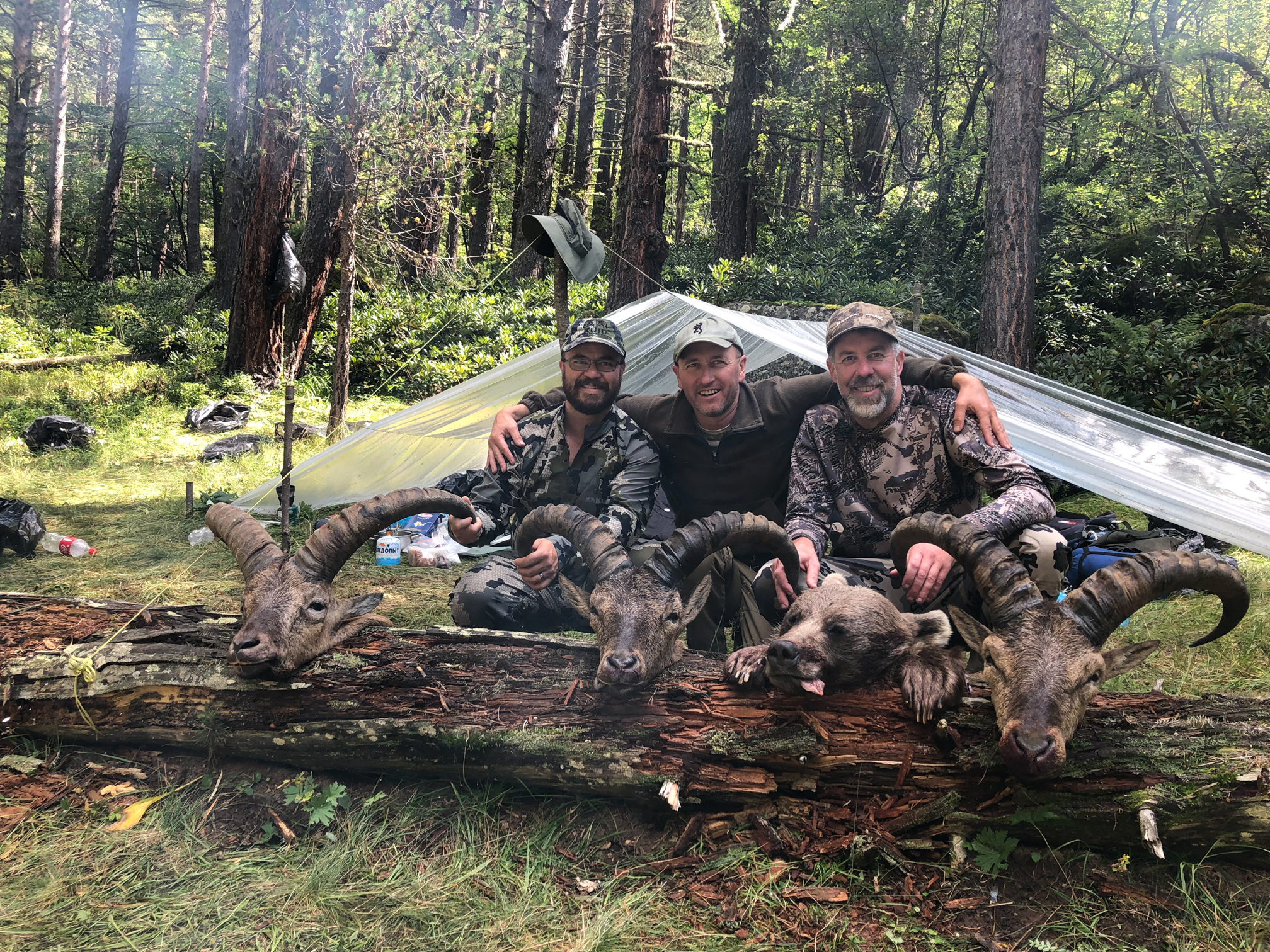
Figuring that they’d gone another 50 yards since I ranged them, I waited until it stopped for a second, then let fly on pretty steep quartering away shot, holding a few inches high. I heard the bullet hit, and after taking a few steps the animal went down.
The scree field, which hadn’t looked that bad from my vantage point, was god-awful. Steep and very loose with some very big rocks and home to some very poisonous Caucasian vipers, it took us a long time to cover that quarter mile. Naurus met us there, and we broke down the animal and headed for home.
I’m going to stop here, as you’ve been more than patient as I ramble on. We did have quite more adventures, including getting eighty-sixed out of a Raddison Blu in Moscow for not having “papers” and mistaking the head of the game department for an Uber driver and insisting that he go and pick up beer for us, but that’s another story….
If you’re interested in going… Tur hunting is one of the best values in mountain hunting. To book a hunt with Denis, contact Ted Shogren at The Sporting Trader (www.sporting-trader.com). Tur were just uplisted to CITES Appendix II, so I would recommend hunting this species sooner rather than later. Make sure you use a qualified importer when shipping trophies, as the CITES paperwork is new for both the Russians and Azerbaijanis, and the USFW has seized quite a few trophies for having incorrect export documentation. While there are three species of tur, USFW only recognizes one of the capra caucasica, kuban tur. If that name isn’t on your CITES permit, you’re going to be in trouble.
You’ll need a visa to travel to Russia. Get this at least three months before you go, and get the three-year visa. We used www.ils-usa.com to get ours. Mine went through without a hitch; Jay’s was very difficult. I’d recommend sending your passport to the Houston service center versus Washington D.C.
While we had enough to eat, the nutritional quality of the food we had in the field left a lot to be desired. Specifically, we were chronically low on protein, which does not lead to quality recovery. I brought rehydration powders (Wilderness Athlete Hydrate and Recover and Liquid IV) gels, Pro-Bars, and Mountain Ops BCA’s with me. If I had known that we’d be spiking out for four days instead of one, I would have brought a bunch more of the BCA’s with me. They didn’t do any good sitting in camp.
You need to have a good rangefinder that corrects for angles. I would be prepared to take a first shot out to 500 yards and know where your bullets are going out to at least 700 in case you need to make a follow-up. Jay and I were both shooting Berger Bullets. Given the distances, I think a highly frangible, soft bullet is a better choice than a mono-metal. On the second tur I shot, the bullet entered behind the rib and was just under the skin on the off-shoulder. I’m still baffled why that first tur didn’t go down. I think some animals are just tougher than others.
You’re going to want boots with a lot of support, but that also has a relatively soft outsole. Hard rubber soles are dangerously slippery when the rocks are wet. The local guides wore rubber barn boots and stuck to the rocks like tur. Unfortunately, my feet and ankles could never handle that. I emailed Kennetrek when I got back asking about finding a boot with a softer outsole. They asked me to send my boots in. After inspecting them, they said that the soles had dried out and that could be causing the problems I was having with traction. They also recommended the K73 sole that they use on the Mountain Guide, so I have a pair of those on the way. Hopefully they’ll be a good solution.
Lastly, be ready to spend a lot of time waiting for paperwork. Between Russia and New York City, I probably spent 12 hours standing around waiting for various people to do their thing. There’s nothing you can do about it, so just relax and enjoy the experience!


